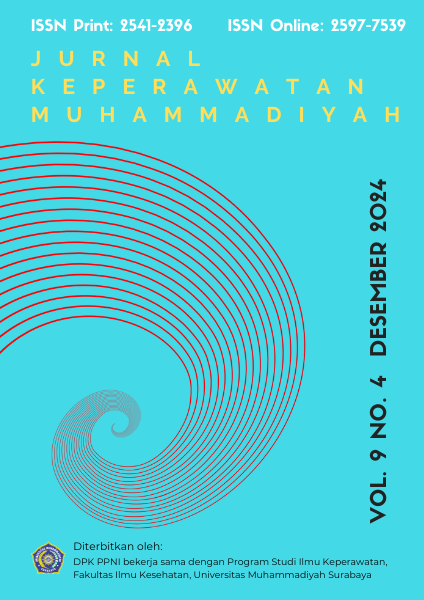Hubungan Pengetahuan, Sikap Dan Paparan Asap Rokok Dengan Kejadian Pneumonia Pada Anak Balita
DOI:
https://doi.org/10.30651/jkm.v9i4.24357Kata Kunci:
Balita, Pneumonia, Paparan asap rokok, SikapAbstrak
Objective: The purpose of this study is to determine the relationship between attitude, knowledge and exposure to cigarette smoke and the incidence of pneumonia in toddlers
Methods: This research is an analytical descriptive research with a cross sectional approach. The population in this study is mothers who have children with pneumonia with a total of 33 toddlers. Sampling technique with the Total Sampling method, Data collection technique using a questionnaire that has been tested for validity and reality.
Results: There was a significant relationship between parental knowledge (p value:0.019; OR: 0.127) and exposure to cigarette smoke (pvalue: 0.02; OR: 7) with the incidence of pneumonia in toddlers and there was no significant relationship between parental attitudes and the incidence of pneumonia (p value:0.09)
Conclusion: There was a significant relationship between maternal knowledge and exposure to cigarette smoke and the incidence of pneumonia in toddlers with a p value of < 0.05, and toddlers exposed to cigarette smoke were 7 times more likely to suffer from pneumonia compared to toddlers who were not exposed to cigarette smoke.
Referensi
Aston, S. J. (2017). Pneumonia in the developing world: characteristic features and approach to management. Respirology, 22(7), 1276–1287. https://doi.org/10.1111/resp.13112
Astuti, S. I., Arso, S. P., & Wigati, P. A. (2019). Hubungan Status Gizi, Jenis Kelamin, dan Ventilasi Rumah dengan Kejadian Pneumonia Pada Balita Di Desa Pelangki Wilayah Kerja UPTD Puskesemas Rawat Inap Muaradua Kabupaten Ogan Komering Ulu Selatan 2018. Analisis Standar Pelayanan Minimal Pada Instalasi Rawat Inap Muaradua Kabupaten Ogan Komering Ulu Selatan 2018, 7, 217–227.
BPS. Badan Pusat Statistik. (2022). Statistik Indonesia 2022. Jakarta: BPS.
Bahri, Raharjo, M., & Suhartono, S. (2021). Dampak polusi udara dalam ruangan pada kejadian kasus pneumonia: sebuah review. Jurnal Link, 17(2), 99–104. https://doi.org/10.31983/link.v17i2.6833
Burns, C. E., Dunn, A. M., Bardy, M. A., Starr, N. B., Blosser, C. G., & Garzon, D. L. (2017). Pediatric Primary Care (sixth). 6th Edition. USA: Elsevier.
Dinkes DKI Jakarta. (2021). Profil kesehatan DKI Jakarta. Jakarta: Dinkes DKI Jakarta. Franciska, D. A. (2018).
Fadl, N., Ashour, A., & Yousry Muhammad, Y. (2020). Pneumonia among under-five children in Alexandria, Egypt: a case-control study. Journal of the Egyptian Public Health Association, 95(1). https://doi.org/10.1186/s42506-020-00043-0
Hassen, S., Getachew, M., Eneyew, B., Keleb, A., Ademas, A., Berihun, G., Berhanu, L., Yenuss, M., Natnael, T., Kebede, A. B., & Sisay, T. (2020). Determinants of acute respiratory infection (ARI) among under-five children in rural areas of Legambo District, South Wollo Zone, Ethiopia: a matched case–control study. International Journal of Infectious Diseases, 96, 688–695. https://doi.org/10.1016/j.ijid.2020.05.012
Hockenberry, M. J., & Wilson, D. (2015). Wong’s Nursing Care Of Infants And Children. 10th Edition. St. Louis, Missouri : Elsevier.
Hidayani, W. R. (2020). Pnemonia : Epidemiologi, Faktor Risiko Pada Balita. CV. Pena Persada, 1–20. Jumiati, H. U. (2017). Hubungan antara sumber informasi, pengetahuan dan perilaku ibu dengan kejadian pneumonia pada balita di wilayah puskesmas kramatwatu kabupaten serang. 106–115.
Kembaren, M. B. S. (2019). Analisis faktor risiko kejadian pneumonia pada balita di Rumah Sakit Umum Kabanjahe Kabupaten Karo. Public Health Journal, 5(2), 23–35. http://36.91.220.51/ojs/index.php/phj/article/view/32/0
Kemenkes. (2019). Buku bagan manajemen terpadu balita sakit (MTBS). Jakarta: Kemenkes. Kemenkes. (2020). Indonesia tegaskan komitmen pencegahan pneumonia di forum internasional. Diakses tanggal 03 Maret 2022, pada https://www.kemkes.go.id/article/view/20013100002/indonesia-tegaskan-komitmenpencegahan-pneumonia-di-forum-internasional.html
Riset kesehatan dasar (RISKESDAS). Jakarta: Kemen Kemenkes. (2020). Pneumonia pada anak bisa dicegah dan diobati. Diakses tanggal 03 Maret 2022, https://www.kemkes.go.id/article/view/20111500001/pneumonia-padaanak-bisa-dicegah-dan-diobati.html Kemenkes. (2021).
Profil Kesehatan Indonesia Tahun 2020. Jakarta: Kemenkes.
Kyle, T., & Carman, S. (2016). Buku ajar keperawatan pediatri. Edisi ke-2. Volume ke-3. Jakarta: EGC.
Khasanah, M., Suhartono, S., & Dharminto, D. (2016). Hubungan Kondisi Lingkungan Dalam Rumah Dengan Kejadian Pneumonia Pada Balita Di Wilayah Kerja Puskesmas Puring Kabupaten Kebumen. Jurnal Kesehatan Masyarakat (e-Journal), 4(5), 27–34.
Merera, A. M. (2021). Determinants of acute respiratory infection among under-five children in rural Ethiopia. BMC Infectious Diseases, 21(1), 1–12. https://doi.org/10.1186/s12879-021-06864-4
Ngocho, J. S., de Jonge, M. I., Minja, L., Olomi, G. A., Mahande, M. J., Msuya, S. E., & Mmbaga, B. T. (2019). Modifiable risk factors for community-acquired pneumonia in children under 5 years of age in resource-poor settings: a case–control study. Tropical Medicine and International Health, 24(4), 484–492. https://doi.org/10.1111/tmi.13211
Nguyen, T. K. P., Tran, T. H., Roberts, C. L., Fox, G. J., Graham, S. M., & Marais, B. J. (2017). Risk factors for child pneumonia - focus on the Western Pacific Region. Paediatric Respiratory Reviews, 21, 95–101. https://doi.org/10.1016/j.prrv.2016.07.002
Nastiti N. Rahajoe, Bambang Supriyatno, D. B. S. (2018). Buku Ajar Respirologi Anak Edisi Pertama. Badan Penerbit Ikatan Dokter Anak Indonesia.
Purwati, N. H., Rustina, Y., & Supriyatno, B. (2021). Knowledge and healthcare-seeking behavior of family caregivers of children with pneumonia: a qualitative study in an urban community in Indonesia. Belitung Nursing Journal, 7(1), 107–112. https://doi.org/https://doi.org/10.33546/bnj.1268
Purwati, N. H., Rustina, Y., & Supriyatno, B. (2022). The unmet needs of family caregivers in the management of childhood community-acquired pneumonia in Indonesia: a qualitative study. Paediatrica Indonesiana, 62(1), 32–36. https://doi.org/10.14238/pi62.1.2022.32-6
Stokes, D. C., & Dozor, A. J. (2018). Pediatric pulmonology, asthma, and sleep medicine : a quick reference guide. USA: American Academy of Pediatrics. UNICEF. (2019). One child dies of pneumonia every 39 seconds, agencies warn. Diakses 25 Maret 2022, pada https://www.unicef.org/press-releases/one-child-dies-pneumoniaevery-39-seconds-agencies-warn UNICEF. (2021). A child dies of pneumonia every 39 seconds. Diakses
Walsh, B. K. (2019). Neonatal and pediatric respiratory care. 5th Edition. Missouri: Elsevier.
Wartono, J. A., Asrifuddin, A., & Kandou, G. D. (2018). Analisis spasial kejadian penyakit pneumonia pada balita di wilayah kerja Puskesmas Tuminting Kota Manado tahun 2017. Kesmas, 7(4). https://ejournal.unsrat.ac.id/index.php/kesmas/article/view/23126 WHO. (2015). Sustainable development goals. Diakses 03 Maret 2022, pada https://www.who.int/health-topics/sustainable-development-goals#tab=tab_1 WHO. (2021). Pneumonia. Diakses 03 Maret 2022, pada https://www.who.int/newsroom/fact-sheets/detail/pneumonia
Unduhan
Diterbitkan
Terbitan
Bagian
Lisensi
Hak Cipta (c) 2024 Nyimas Heny Purwati, Dhea Natasha, Irma Permatasari, Indanah, Endah Nurohmah, Ai Maemunah

Artikel ini berlisensiCreative Commons Attribution-ShareAlike 4.0 International License.
- Penulis tetap memegang hak atas karyanya dan memberikan hak publikasi pertama kepada jurnal ini yang secara simultan karya tersebut dilisensikan di bawah:Â Creative Commons Attribution-ShareAlike 4.0 International (CC BY-SA 4.0)













